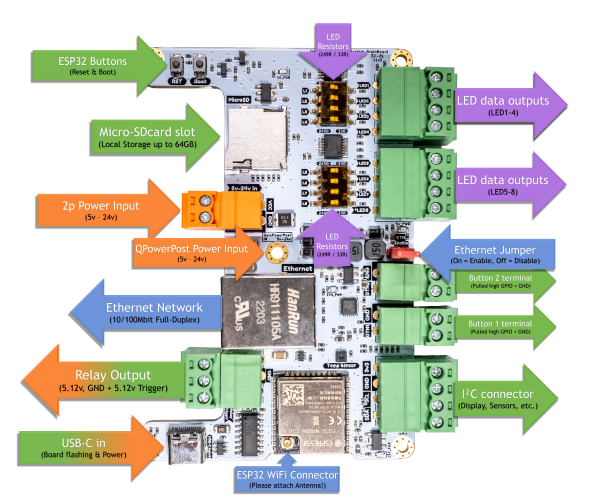QuinLED-Dig-Octa System
Brainboard-32-8L
Specifications
The QuinLED-Dig-Octa Brainboard-32-8L is the first brainboard in what is set to become various brainboard versions in the future. This board has been designed with a good mix of features on there instead of singular design focus like some future boards will have.
Design Goal
The QuinLED-Dig-Octa Brainboard-32-8L is based around the Espressif ESP32 WROOM module. This gives it a good amount of power to drive LEDs while also allowing a variety of options to generate the LED data either locally or remote.
Specifications
- Based around Espressif ESP32-WROOM-32UE
- Dual-Core 240Mhz microcontroller
- 520 KB SRAM with 4MB of Flash Storage
- WiFi (2.4Ghz 802.11N) and Ethernet capabilities
- External WiFi Antenna only
- Built-in WiFi + Ethernet
- The board can be used over WiFi using an external antenna connection
- Comes delivered with the board!
- Ideal for use in enclosures or when longer range is required
- You can swap to a high-gain antenna
- Onboard RJ45 10/100Mbit Ethernet provided by the LAN8720A chip
- Very stable connection and able to handle real-time pixel data much better then WiFi
- The board can be used over WiFi using an external antenna connection
- SDcard reader
- Onboard SPI connected MicroSD card slot
- I²C*
- I²C terminals + power available
- Onboard SHT30 I²C temperature & humidity sensor
- 3x simultaneous power-in connections
- 5v USB-C
- Includes onboard CH340 USB-to-Serial
- Auto-reset to program mode circuit on board
- 5v-24v 2p 3.81mm pluggable connector
- 5v-24v QPowerPost power feed
- 5v USB-C
- Dedicated relay output terminals
- 5.12v out, GND and Relay trigger (5.12v) available on 3p 3.81mm pluggable connection
- Compatible with High or Low trigger relay boards
- Strong enough to trigger multiple multiple relays at the same time
- Dedicated Relay on/off LED (blue)
- 2x input button/switch terminals
- HW debounced and pulled-high
- Including 2x GND terminal
- Boot/Reset buttons available
- For manual control of the board
- 5x M2.5 board mounting holes
- Outer are 4x GND
- Inner is VCC in (only)
*See shared resources below
LED features
- 8x level-shifted LED data output channels
- Level-shifted using 2x 4 port level-shifters to 5.12v with 8mA max per channel
- 2x 4p 3.81mm pluggable terminals
- Per channel resistor DIP switches
- Defaults to 249Ω but can be switches per port to 33Ω for better compatibility with 3-wire cable setups
- “Hardware driven” using ESP32 RMT device channels
Specials
- Compatible with QPowerPost
- Allows powerboard power to be shared with brainboard
- No wires to brainboard needed!
- Fully mixed voltage powerboard stack compatible
- Allows powerboard power to be shared with brainboard
- Custom DC-DC circuit allowing 3v-24v in while always providing 5.12v out (for onboard electronics, relay and data signals only!)
- Max advised power draw 750mA
- All inputs designed with protection circuits
- Fully allowed to use multiple power inputs at the same time with mixed voltages
- Designed to provide stable power even when switching on/off various power sources (auto switches between voltages while staying online)
- For instance when using relay feature to turn off LED power supply to powerboard and keeping the brainboard online using 5v USB-C
- 3x 800mA 3.3v LDO onboard for extra stability
- ESP32 section
- LAN section
- SDcard section
- LAN enable jumper
- To save a GPIO there is no trigger GPIO for the Ethernet chip but to save power it can still be disabled using a physical jumper
- MOSFET based relay circuit
- Provides 5.12v out independent of input voltage
- P-Channel and N-Channel MOSFET based relay circuit allowing you to drive multiple relays using a single output and trigger terminal
- When using multiple powerboards for instance
- Board design
- Shape is designed to be fit on top of a powerboard while keeping power input and output fuse + terminals available
- Designed with stackability in mind, all ports remain usable even when stacked
Shared resources
Sadly the ESP32 doesn’t have an unlimited amount of GPIOs available. Because of this on this board:
- LED8 and I2C SCL share the same GPIO pin
- This means you will have to choose between either feature on this board
Suggested handling capabilities
Although the ESP32 can handle a good amount of LEDs it’s capabilities are limited. The suggested max amount of LEDs per board are also partly dependent on the software you are running on the board. Please see max LEDs per data channel and FPS here.
- WLED
- For WLED a total of ~2000 LEDs divided over the 8 output ports is suggested
- ESPixelstick v4
- For ESPixelstick a total of ~3000 LEDs divided over the 8 output ports is suggested
- ESPixelstick is much “lighter” firmware and it handles the processing of the LED data differently allowing a bit more performance
- For ESPixelstick a total of ~3000 LEDs divided over the 8 output ports is suggested

